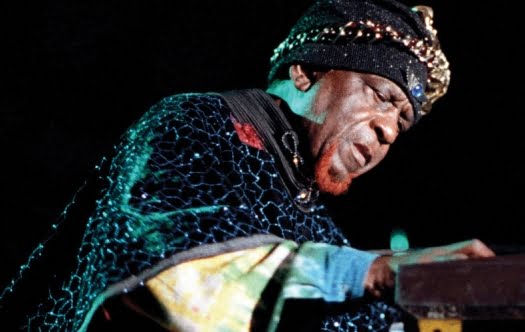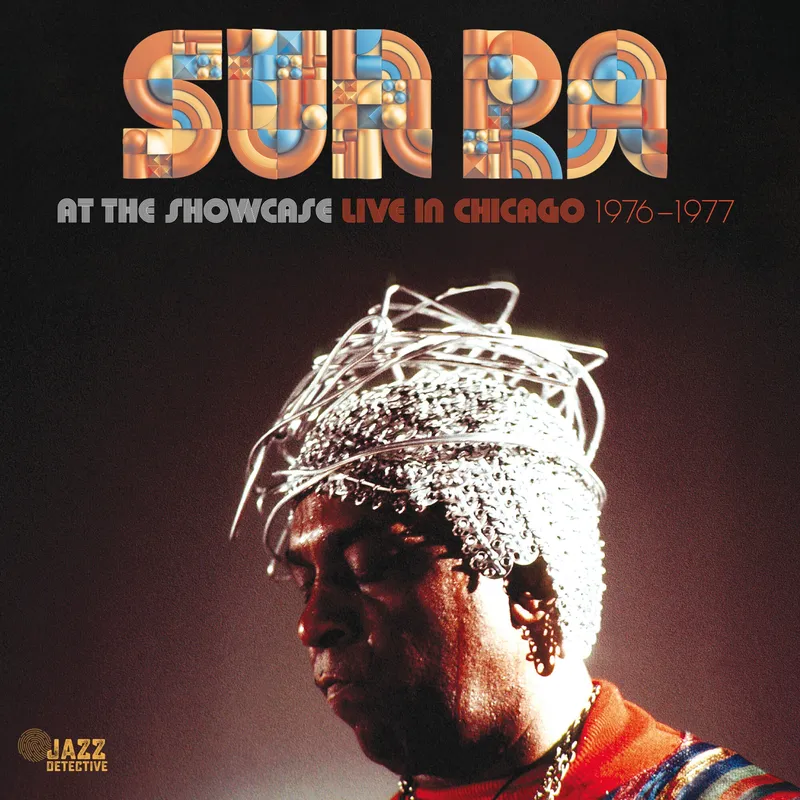Despite Sun Ra having passed on over 30 years ago, his ethos is still with us: the Arkestra lives on under the leadership of saxophonist Marshall Allen, now into his very late 90s. Anyone having seen the band “live” over the last few years will agree that his spirit is very much alive in the contemporary presentation.
I am listening to the exquisitely produced LPs of previously unissued live sets by the Sun Ra Arkestra. Though official records have him named Herman Blount — born in Birmingham, Alabama in 1914 — Sun Ra claimed to have come from Saturn (or sometimes Mars). He named himself after the Egyptian sun god.
Yes, these claims may come off as eccentric — I found them charmingly fanciful — but his shows were delightful visually, and musically satisfying. The bandleader appeared in flowing gowns, wearing complicated crown-like head pieces, sometimes carrying a wand. I remember seeing the Arkestra in Ann Arbor: everyone was costumed; there were singers such as June Tyson; and some dancing. Sun Ra himself looked soberly out at the crowd, whom he addressed as space people. Earth people pollute and are racist, he claimed. By choosing to attend his performance, we proved ourselves to be space people who were wise to what was going on. Space is the place, the band chanted while circling the limited space of the Ann Arbor stage. His Arkestra members were strikingly loyal: the celebrated tenor saxophonist John Gilmore first recorded with Sun Ra in 1956, and continued into the ’90s. After recording several times with another alto player, James Moody, alto saxophonist and flutist Marshall Allen hooked up with the Arkestra in 1957 or 1958 and never let go. After his leader’s death in 1993, Allen has led a ghost band version of the Arkestra. He still does, at age 99.
To my mind, the music of the Arkestra is, as the title of one of my favorite Ra recordings proclaims, the sound of joy (1956’s The Sound of Joy, Delmark). His compositions can often contain many parts, such as the tune “El is the Sound of Joy.” They tend to include a variety of percussive sounds, as well as Ra’s wild, sometimes even aggressive, piano solos. But then he can sound gentle on electronic keyboards as well. Frequently, he swings. Today Sun Ra would be called an Afro-futurist, but at the beginning of his career Ra recorded with blues man Red Saunders. He was the pianist on a Savoy set led by the venerable Coleman Hawkins. Then Sun Ra rushed into outer space with early records like The Heliocentric World of Sun Ra. (It’s too bad listeners can’t see the original covers: one album from the period features a photo of Sun Ra lined up with his far-seeing predecessors, including Galileo.)
On these live sets at the Jazz Showcase, the future seems to have caught up with Sun Ra. The final number in the 1976 lineup is called “Greetings From The Century Of 21.” Jazz Detective wisely offers the stronger, later set (from November 4-10, 1977) first; appropriately enough, it opens with a group improvisation called “New Beginning.” It is more or less out of tempo. There is always time aplenty, and space, in Sun Ra’s music. The flutists, Marshall Allen and either Danny Davis or Danny Thompson, play interweaving lines that are harmonically neither here nor there. In the background we hear a variety of percussive sounds, the kora, I believe, and various drums. It’s a short piece and leads directly into another percussion passage, this time coming from what sounds like sticks on a rim; some tom toms and bass drum gradually join in to create a gently swinging beat. Eventually we hear Vincent Chancy on French horn playing, and then repeating, a mournful, two-note phrase. After almost three minutes, Sun Ra suddenly intrudes on an electric keyboard. He plays eerie, high-pitched sounds, eventually churning out chords that could have come out of a horror movie soundtrack. Gradually, his improvisations verge on the realm of the swinging. These passages also jump in and out of tempo; they include thumping or shrieking sounds that seem in conversation with each other but with no one else. Ra brings in the band at around six minutes. It’s free jazz at its best.
This never before released music is very typical of what might be determined as middle-period Ra. The slightly earlier material on CD1 embraces much of the leader’s grounding in more conventional forms, which included a stint as pianist and arranger for the ailing Fletcher Henderson in the 1940s. There is plenty of swing-based music here, including the slightly off-centre Rose Room, all driven along by the sometimes rudimentary but perhaps appropriate drumming of Luqman Ali.

Sun Ra and band performing at the Ann Arbor Blues and Jazz festival, 1973.
Next is Ra’s “Synthesis Approach,” which again opens with the composer/bandleader on keyboards. This time, though, he starts out with a melody that the band picks up on in rip-roaring style. It explodes into a bunch of riffs that the variety of sounds make constantly engrossing. Sun Ra keeps on rockin’ in the ensuing “Ankhnaton.” The second side contains the one non Ra ballad on the Jazz Showcase sets. “Rose Room” is the Hickman-Williams composition that Duke Ellington recorded as far back as 1932. Sun Ra plays it uptempo and in a disorderly style, adding various loosely organized riffs behind John Gilmore’s tenor sax solo. Sun Ra’s solo is accompanied only by the rhythm section. “Moonship Journey” is a light-hearted piece during which the band sings, inviting us to take a moonship journey. The band is welcoming: the audience is encouraged to chant along as well as journey along.
The music of the second LP (recorded on February 21, 1976) begins with one of the package’s highlights, a 17 minute version of “Calling Planet Earth/ The Shadow World.” This set is far more vocal: the band starts things off by yelling “Earth,” as if it was delivering surprising news. This track contains the best example of Ra’s outer-space keyboard work. He doesn’t play what I would call phrases, but rather a series of unexpected sounds: deep bass trills, chittering, rapid sounds in the treble that sound at one point like the exchanges of anxious mice. These are keyboard sounds that I haven’t heard elsewhere. The band comes in, contributing a blaring group improvisation. Then Sun Ra settles things down with a repeated riff that is the basis of most of the rest of the song.
If I say I prefer the 1977 date, it’s not that I am not grateful for what Ra did in 1976. But this long version of “Space is the Place” has the band and audience chanting the title for what feels like an excessively long time. Having repeatedly seen the Arkestra do this number live, I imagine the band is marching around the club: it’s part grand theater and we can’t see the no doubt zesty dramatics. This piece is followed by a minute and forty five seconds of applause — which is given its own track. The record gets back on track with “Ebah Speaks In Cosmic Tongue,” an improvised vocal that features someone singing the question “Have you heard the latest news from Neptune?” followed by a vocal solo in what sounds like gibberish — if you don’t speak Neptunese. The set winds-up with “Greetings From The Century Of 21.” The records have been elegantly packaged: the accompanying booklet contains fragments of informative interviews with the likes of Jack DeJohnette, Dave Burrell, and Reggie Workman.







More Stories
CD review: George Benson – Dreams Do Come True: When George Benson Meets Robert Farnon – 2024: Video, CD cover
The band was tight as ever. The Warren Haynes Band cuts loose: Video, Photos
Interview with Alvin Queen: Feeling Good – I heard these tunes played by … Video, new CD cover, Photos